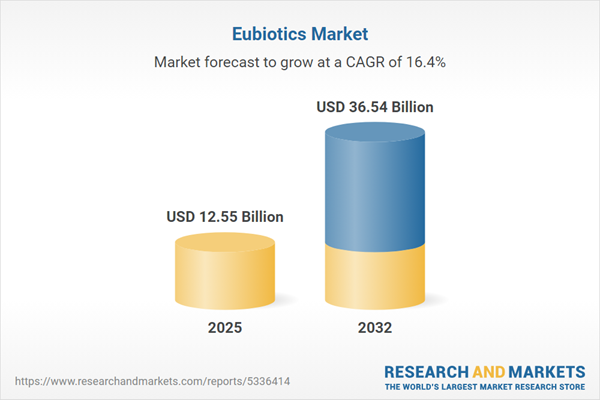Speak directly to the analyst to clarify any post sales queries you may have.
The eubiotics market is transforming animal nutrition as organizations manage compliance, sustainability, and operational innovation. Senior leaders face continuous change driven by complex regulations and new technologies that are shaping both the competitive landscape and supply chain practices.
Eubiotics Market Snapshot: Size and Growth Dynamics
The global eubiotics market is demonstrating sustained growth, projected to expand from USD 10.80 billion in 2024 to USD 12.55 billion in 2025, and forecasted to reach USD 36.54 billion by 2032. The market is advancing at a compound annual growth rate of 16.44%, supported by rising investment in cutting-edge feed additives, industry partnerships, and a sharper focus on animal health management. Technology integration and digitalization are streamlining feed supply chains, increasing operational resilience, and ensuring more effective animal nutrition strategies across key regions.
Eubiotics Market Scope & Segmentation
- Product Types: Solutions include enzymes, organic acids, phytogenics, prebiotics, probiotics, and synbiotics, each optimizing feed efficiency and supporting animal well-being in diverse production environments.
- Phytogenics: Herbal extracts, oleoresins, and spice derivatives help organizations align with region-specific regulations and advance environmental objectives.
- Probiotics: Strains such as Bacillus, Enterococcus, Lactobacillus, and Saccharomyces promote digestive health and enhance animal performance across different rearing systems.
- Livestock Types: Eubiotics are formulated for aquaculture, ruminant, swine, and poultry, enabling compliance and productivity across global operations.
- Forms: Available formats—dry concentrates, liquid emulsions, premixes, and suspensions—address manufacturing requirements for both major producers and specialized operations.
- Functions: Improving gut health, supporting feed utilization, optimizing growth, enabling immune support, and contributing to pathogen management within the animal nutrition value chain.
- Sales Channels: Distribution spans traditional channels and digital procurement, giving industry stakeholders the flexibility to manage supply visibility and response times efficiently.
- Geographies: Regional performance is driven by specific regulatory frameworks, demographic trends, and speed of technology adoption in the Americas, Europe, Middle East & Africa, and Asia-Pacific.
- Industry Leaders: Major contributors such as Koninklijke DSM N.V., Evonik Industries AG, Novozymes A/S, Chr. Hansen Holding A/S, Cargill, Archer Daniels Midland Company, Kerry Group, BASF SE, DuPont de Nemours, and Ajinomoto are steering innovation and setting operational standards.
Eubiotics Market: Key Takeaways for Senior Leaders
- New advances in fermentation and encapsulation processes are strengthening nutrient delivery and operational responsiveness within animal health initiatives.
- Reductions in antibiotic use are reshaping production systems to better meet regulatory obligations and address customer requirements for sustainability and quality.
- Growing digitalization is enhancing process oversight, supporting data-driven compliance, and strengthening risk management amid evolving regulations.
- Partnerships among feed producers, biotech innovators, and research institutions are enabling rapid product development and market adaptation in competitive environments.
- Automating procurement and inventory supports stronger supply chain continuity and helps organizations anticipate and mitigate critical sourcing risks.
- Expanding local talent and knowledge is helping businesses remain agile and competitive during times of regulatory or market transition.
Tariff Impact: US Measures and Global Trade Realignment
Recent shifts in US tariff policies are prompting the eubiotics sector to reassess global trade frameworks and strategies for supply assurance. Businesses are prioritizing regionalized manufacturing and nearshoring, making vertical integration more essential to curb volatility. Enhanced partnerships with local suppliers and intra-regional networks are supporting regulatory compliance and stabilized business operations as trade patterns continue to change.
Methodology & Data Sources
This report synthesizes primary research from industry expert interviews, comprehensive secondary research, and robust quantitative analysis. All findings are validated by animal nutrition professionals to ensure they deliver credible guidance and practical utility for business stakeholders.
Why This Report Matters
- Delivers a structured analysis of regulatory, technology, and regional factors that influence the eubiotics landscape for senior-level decision-making.
- Equips executives with actionable strategies for compliance, innovation, and risk management as industry conditions shift.
- Identifies targeted pathways for differentiation and sustainable growth in the evolving animal nutrition sector.
Conclusion
This report guides senior leaders as they adjust strategies and reinforce risk protocols, ensuring continued confidence and resilience in the changing animal nutrition and eubiotics markets.
Additional Product Information:
- Purchase of this report includes 1 year online access with quarterly updates.
- This report can be updated on request. Please contact our Customer Experience team using the Ask a Question widget on our website.
Table of Contents
3. Executive Summary
4. Market Overview
7. Cumulative Impact of Artificial Intelligence 2025
Companies Mentioned
The companies profiled in this Eubiotics market report include:- Koninklijke DSM N.V.
- Evonik Industries AG
- Novozymes A/S
- Chr. Hansen Holding A/S
- Cargill, Incorporated
- Archer Daniels Midland Company
- Kerry Group plc
- BASF SE
- DuPont de Nemours, Inc.
- Ajinomoto Co., Inc.
Table Information
| Report Attribute | Details |
|---|---|
| No. of Pages | 198 |
| Published | October 2025 |
| Forecast Period | 2025 - 2032 |
| Estimated Market Value ( USD | $ 12.55 Billion |
| Forecasted Market Value ( USD | $ 36.54 Billion |
| Compound Annual Growth Rate | 16.4% |
| Regions Covered | Global |
| No. of Companies Mentioned | 11 |









